Ross Eaton writes a detailed tactical analysis on the UEFA Champions League Round of 16 second leg match that ended Napoli 1-3 Real Madrid.
An intense first leg which saw Maurizio Sarri’s Napoli lose 3-1 at the Bernabeu left the tie tipped in Real Madrid’s favour, yet very much remaining open. The Italian side have impressed this season, despite the loss of a key player in summer, and his big money replacement just weeks later, seeing them strongly push for glory in all competitions they are involved in. They will take part in another interesting battle with Zidane’s La Real, who have played a different, individual-based strategy compared to the combination all, support-orientated game of Napoli. At the San Paolo, Napoli looked to overturn a tough, yet not irrecoverable deficit against Real Madrid.
Line Ups:
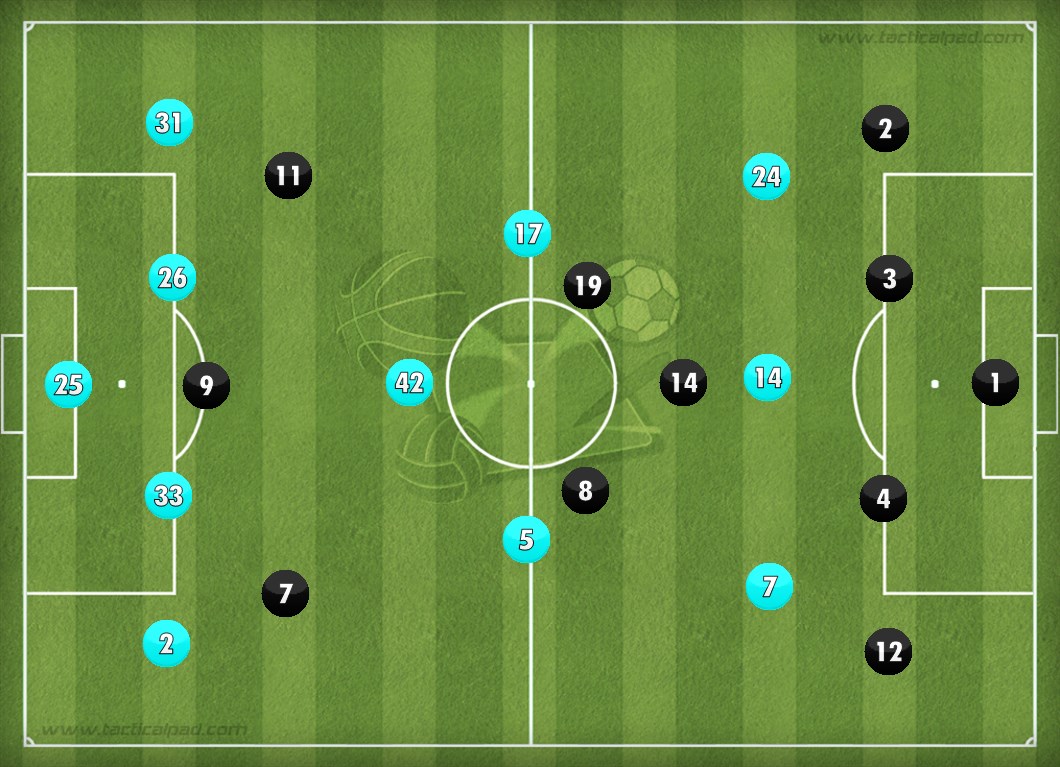
Made using TacticalPad
Napoli: Reina; Hysaj, 33. Albiol, 26. Koulibaly, 31. Ghoulam; 5. Allan, 42. Diawara, 17. Hamsik; 7. Callejon, 14. Mertens, 24. Insigne.
Real Madrid: K. Navas; 2. Carvajal, 3. Pepe, 4. Sergio Ramos, 12. Marcelo; 19. Modric, 14. Casemiro, 8. Kroos; 11. Bale, 9. Benzema, 7. C. Ronaldo.
Napoli selected the following team: Pepe Reina the GK. Elseid Hysaj and Ghoulam as the right and left full-backs, centred by Raul Albiol and Koulibaly. Diawara was selected as the pivot, with the combative Allan chosen as the right central-mid ahead of Zielinski and Rog. Hamsik as left 8. The front was Callejon right-wing, Mertens as the central forward and Lorenzo Insigne off the left wing.
Los Blancos chose a pretty standard XI. Keylor Navas the goalie, protected by Carvajal, Pepe, Sergio Ramos and Marcelo. Casemiro was the 6, with Modric and Kroos as standard 8’s to his right and left. Bale, Benzema, Ronaldo were the forwards.
Ineffective Pressing Scheme Forced to Adjust
Pressing from their base 4-3-3 shape against the clean, efficient build-up of Sarri’s Napoli, Zidane’s Real Madrid side looked to put a respectable degree of pressure on Napoli’s first and second line in a mid-high block. Despite this, Los Blancos were forced to defend in a slightly passive, mid block.
Not really having an overly major focus on their compactness on either axis, horizontally nor vertically, Real found it difficult to maintain consistent defensive access in the first phase of Napoli’s build-up, due to the lack of ball-local compactness in the advanced lines of their press. One aspect of Real’s pressing scheme they used in an attempt to have some defensive connection between the first line of pressure and the rest of the block was by their ball-near 8 pushing up.
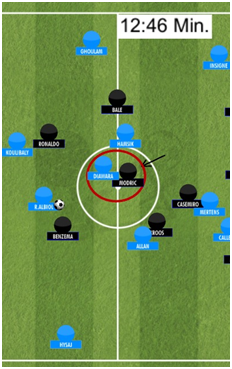
This was likely in an attempt to prevent Diawara receiving behind Real’s first line of pressure, as he would either be marked, or if the Gabonese regista did, he would have pressure on him relatively quickly.
This pressing scheme was largely ineffective for Madrid though. Napoli often had numerical and spatial superiorities in their first one or two lines, thanks for dropping and splitting movements by deep players. Napoli would regularly overload a space, often out wide where pressure is typically upped in intensity and more difficult to escape, in order to create strong structure local to the ball. This allowed Partonopei to make clean combinations, usually with needle players, to escape the pressure of Madrid. These combinations saw Napoli draw in an intense Real press on the backline, only for it to be escaped and progression through vacated spaces to be possible. As Napoli frequently progressed through the centre areas, using the 8’s imperatively, Real were forced to adjust and alter their focus to midfield pressing. This saw Real fall into more of a compact mid block. Here we saw Napoli find progression and penetration more challenging, though still very much possible due to their quality.
Exploiting the Press Between Lines
Against the previously mentioned weak initial pressing of Real Madrid, Napoli commonly used horizontal movements within the centre to exploit Real’s scheme from within the block.
With Madrid’s CM’s situationally stepping up to press slightly higher than the rest of midfield line, this usually naturally left a relatively large gap. With Casemiro tasked with blocking Dries Mertens, he was unable to shift and cover this space.
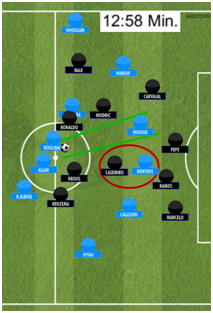
This left a very large midfield space behind Real’s ball-near CM who pushed up, which a number of Napoli players did exploit. Behind Real’s advanced CM, Napoli’s 8 would make small horizontal movements either wide into the halfspace, or into the centre. On the blind side of Real’s pressing CM, it was very difficult for this player to both block the lane and maintain access on Napoli’s deep build-up. The Napoli 8 would usually successfully manage to create a viable angle from their CB, which allowed them to receive between Real’s lines. If the timing and execution of the Napoli CB’s pass was good, then it would be very difficult for Kroos/Modric to intercept, as their high positioning meant less reaction time to intercept.
As well as Napoli’s 8’s being vital to them receiving and progressing into position between the lines, centre forward Dries Mertens was greatly important too. Casemiro’s man-orientation on the Belgian attacker often gave him the control to manipulate the Real destroyer’s positioning defensively. If Casemiro did mark him closely, the above mentioned would occur. If not, this gave Mertens the opportunity to drop between the lines, find a pocket of space, and receive the ball in front of the Real backline.
Another couple of important players for Napoli exploiting the pockets of space between Real’s defence and midfield were Hamsik and Lorenzo Insigne. Key in Hamsik and Insigne’s receiving between the lines, Mertens would commonly make drifting movements towards the right halfspace. This often drew Casemiro towards Napoli’s right, Real’s left slightly. With one Real CM pushed on and other tucked in slightly, this left Napoli’s left halfspace widely open. Supporting Lorenzo Insigne in his dream, an open left halfspace, Hamsik would move into this space alongside Insigne. If the ball was with Raul Albiol, one of the pair would make small movements, normally vertically, within the left halfspace, to find an open right halfspace-left halfspace passing lane. This was rather common, and highlighted Modric’s overzealous pushing on. If the ball was with Kouliably, horizontal movements from within the halfspace, usually from Hamsik here, would be made to create an open lane for a Koulibaly laser pass.
Pressing Dynamic and Failure to Exploit
Napoli faced a flawed press, and featured aspects and patterns within their play which largely allowed them to control the dynamics of the match, particularly in certain periods throughout. Pressing very ambitiously, though also with flaws, Napoli were not exploited to the extent their opponents were by them.
Pressing with unbelievable intensity (perhaps even more so unbelievable that they could retain it pretty much all throughout the match) Napoli squeezed mostly in a 4-5-1 formation. This saw their deepest midfielder Amadou Diawada push up between Allan and Hamsik into a central role, mostly man-orientated on Casemiro. Pressing Real by stepping out of their own midfield line when the ball reached Real’s second line, Napoli’s press was very intense and relied somewhat on strong communication by players to shift and cover frequently. The midfield five, positioned very high up, just a few metres from frontman Dries Mertens, had a great distance from their defence, lacking much vertical compactness.
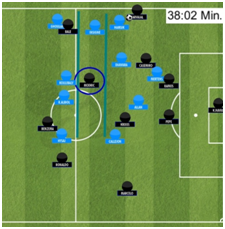
Modric and Kroos someimes moved behind Napoli’s midfield line, but not often enough
This was one area Real Madrid failed exploit. Luka Modric and Toni Kroos rather sat in deeper 8 or standard 8 positions, preferring to provide immediate support to the ball, instead of moving higher up into this space behind Napoli’s midfield, rather than within it.
Another issue with Real’s CM’s in exploiting the space behind Partonopei’s midfield line was the efficiency of Allan, Diawara and Hamsik in blocking and marking out Kroos, Casemiro and Modric. Napoli’s central midfield trio efficiently carried out the difficult task of vertically pressing and pushing forward, whilst blocking vertical passing lanes to their near opposition CM.
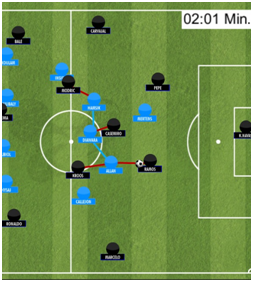
This made it very difficult for the 8’s to be connected, due to them being blocked from the initial pass, but also Casemiro, a potential alternative, being inefficient with his movements to support with progression.
As well as these methods, Madrid used the commonly utilised horizontal circulation in an attempt to manipulate and disorientate the press of their opponents. They would attempt to move the ball out wide to a full-back, who would draw the press of their near-winger and potentially near-CM also. From here, they would ideally have created some space centrally, where they could pass directly into, or go to the backline (Pepe or Ramos) firstly, who would then attempt to play a penetrative pass through the centre. This was where we saw the true extent of how great Napoli’s pressing and covering shifts were. Whoever had better access between the outer CM and winger, would press the full-back very intensely, showing him the touchline, whilst his partner covered the halfspace inside of him. Both of these features prevented Real from consistently or cleanly progressing into the centre from a wide area.
In an extremely ambitious defensive approach against a team possessing players such as Toni Kroos and Luka Modric, the positivity shown from Maurizio Sarri and his men was admirable. Not only the idea, but the execution of the plan, was wonderful. Though not suited to all opposition, a strong progressional structure has great potential to exploit such a system (see Napoli’s performance), there is no doubt that for this match, this pressing scheme was effective.
Conclusion
Though on the end of a 6-2 aggregate defeat, and facing exit from the Champions League, Maurizio Sarri’s SSC Napoli side have won the hearts of many. Their ambitious performance against the competition’s current holders was one which can rarely be faulted. The turning point(s) in the game was undoubtedly Sergio Ramos’ header to draw Real Madrid equal on the night. Up until then, Napoli’s dynamics, particularly in possession, were extremely clean and effective. The momentum shifts however, altered the match slightly, and the Neapolitans weren’t able to fully recover to their peak.
Read all our tactical analyses here
- Tactical Analysis: Nice 4-0 Monaco | Favre’s efficient approach - September 14, 2017
- Tactical Analysis: Australia 2-3 Germany | German Defensive Scheme - June 22, 2017
- Tactical Analysis: Napoli 1-3 Real Madrid | Napoli unable to shift momentum - March 9, 2017























































